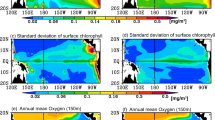Summary
Radiative transfer modelling for a coupled ocean-atmosphere system near 685 nm indicates a sufficiently high fluorescence signal of the chlorophyll a transmitted to the top of the atmosphere. However, only the shortwave half is seen at the top of the atmosphere, the longwave half is fully masked by atmospheric oxygen and water vapour absorption. The impact of atmospheric aerosol extinction on the signal transmission is almost negligible. The Hα line of the sun, atmospheric water vapour absorption, and chlorophyll absorption near 670 nm influence radiative transfer in the shortwave tail of the fluorescence line making the search for a baseline in order to eliminate the background radiation a difficult task.
Zusammenfassung
Die Strahlungsübertragungsgleichung wird für ein Atmosphäre-Ozean-System auf Grundlage der Matrix-Operator-Methode gelöst, um das Transmissionsverhalten der Atmosphäre in der Nähe der Chlorophyll-a-Fluoreszenz bei 685 nm im Hinblick auf die Fernerkundung des ozeanischen Phytoplanktons zu untersuchen. Während der kurzwellige Teil der Fluoreszenz vollständig zum Atmosphärenrand transmittiert wird, ist die langwellige Hälfte von der atmosphärischen Sauerstoff- und Wasserdampfabsorption völlig maskiert. Die Simulationsrechnungen zeigen, daß der Einfluß atmosphärischer Aerosole auf die Transmission des Signals nahezu vernachlässigbar ist. Dagegen stören eine Hα-Linie der Sonne, atmosphärische Wasserdampfabsorption und die Chlorophyllabsorption nahe 670 nm die Strahlungsübertragung des langwelligen Teils derart stark, daß die Suche nach einer Basislinie zur Eliminierung der Hintergrundstrahlung schwierig wird.
Résumé
L'équation de transmission du rayonnement pour un système combiné océanatmosphère est résolue à l'aide de la méthode opérateur-matrice en vue de définir les caractéristiques de transmission de la fluorescence chlorophylienne-a à 685 nm en tenant compte de la reconnaissance à distance du phytoplancton océanique. Le spectre onde courte de la fluorescence est transmis entièrement à la partie supérieure de l'atmosphère alors que le spectre onde longue est entièrement masqué par l'absorption due à la vapeur d'eau et à l'oxygène dans l'atmosphère. Les calculs de simulation montrent que l'influence des aérosols sur la transmission du signal est quasiment négligeable. Par contre, la raie Hα du soleil, l'absorption par la vapeur d'eau atmosphérique et de la chlorophylle à environ 670 nm affectent la transmission du rayonnement si fortement qu'il est malaisé de rechercher une ligne de base en vue de supprimer le rayonnement ambiant.
Similar content being viewed by others
References
Austin, R. W., 1974: The remote sensing of spectral radiance from below the ocean surface. In: Optical aspects of oceanography. (Ed.: N. G. Jerlov and E. Steemann Nielsen.). New York: Academic Pr. pp. 317–344.
Delbouille, L., G. Roland and L. Neven, 1981. Photometric atlas of the solar spectrum from λ 3000 to λ 10 000. Liège: Institut d'Astrophysique de l'Université, Observatoire Royal de Belgique. [Data tape.]
Dörffer, R., 1981: Factor analysis in the ocean colour interpretation. In: Oceanography from space. Proc. of the COSPAR (Committee for Space Research)/SCOR (Scient. Committee for Oceanic Research)/IUCRM (Inter-Union Commiss. Radio Meteorol.) Symposium held 1980 in Venice. New York: Plenum Pr. pp. 339–345.
Dütsch, H. U., 1970: Absorptionskoeffizienten des Ozons. In: Meteorologisches Taschenbuch. Bd. 2. (Ed.: F. Linke und F. Bauer.) p. 255.
Fischer, J., 1984: Fernerkundung von Schwebstoffen im Ozean. Hamburger Geophys. Einzelschr. (A) 65.
Fischer, J. and H. Graßl, 1984: Radiative transfer in an atmosphere-ocean-system: An azimuthally dependent matrix-operator approach. Appl. Optics.23, April issue.
Goody, R. M. 1964: Atmospheric radiation. P. 1. Oxford: Claredon Pr. XI, 436 pp.
Gordon, H. R., 1979: Diffuse reflection of the ocean, the theory of its augmentation by chlorophyll a fluorescence at 685 nm. Appl. Optics.18, 1161–1166.
Gordon, H. R., D. K. Clark and W. A. Hovis, 1980: Phytoplankton pigments from the NIMBUS-7 Coastal Zone Colour Scanner: Comparison with surface measurements. Science.210, 63–66.
Gower, J. F. R. and G. Borstad, 1981: Use of the in vivo fluorescence line at 685 nm for remote sensing surveys of surface chlorophyll a. In: Oceanography from space. Proc. of the COSPAR (Committee for Space Research)/SCOR (Scient. Committee for Oceanic Research)/IUCRM (Inter-Union Commiss. Radio Meteorol.) Symposium held 1980 in Venice. New York: Plenum Pr.
Højerslev, N. K., 1979: On the origin of yellow substances in the marine environment. Proc. Workshop on the Eurosep OCS Experiment, Oct. 1979.
Kiefer, D. A., 1973: Fluorescence properties of natural phytoplankton populations. Mar. Biol.22, 263–269.
Labs, D. and H. Neckel, 1970: Transformation of the absolute solar radiation data into the “International practical temperature scale of 1968”. Solar Phys.15, 79–87.
McClatchey, R. A. and L. S. Rothman, 1978: Atmospheric absorption line parameters compilation. Bedford, Mass.: Air Force Geophysics Laboratories. [Data tape.]
Morel, A., 1974: Optical properties of pure water and pure sea water. In: Optical aspects of oceanography. (Ed.: N. G. Jerlov and E. Steemann Nielsen.) New York: Academic Pr. pp. 1–24.
Morel, A., 1980: In-water and remote measurements of ocean color. Bound. Layer Meteorol.18, 177–201.
Neville, R. A., and J. F. R. Gower, 1977: Passive remote sensing of phytoplankton via chlorophyll a fluorescence. J. Geophys. Res.82, 3487–3493.
Plass, G. N., G. E. Kattawar and G. E. Catchings, 1973: Matrix-operator theory of radiative transfer. Appl. Optics.12, 314–329.
Prieur, L. and S. Sathyendranath, 1981: An optical classification of coastal oceanic waters based on the specific spectral absorption curves of phytoplankton pigments, dissolved organic matter and other particulate materials. Limnol. Oceanogr.26, 671–689.
Quenzel, H. and M. Kästner, 1978: Remote sensing of chlorophyll in the ocean: Masking effects of the atmosphere. Wiss. Mitt. Univ. München. Nr. 33.
Rodgers, C. D. and C. D. Walshaw, 1966: The computation of infra-red cooling rate in planetary atmospheres. Quart. J. Roy. Met. Soc.92, 67–92.
Yentsch, C. S., 1960: The influence of phytoplankton pigments on the colour of seawater. Deep-Sea Res.7, 1–9.
Author information
Authors and Affiliations
Rights and permissions
About this article
Cite this article
Schlüssel, P., Graßl, H. Transmission of the oceanic chlorophyll fluorescence to the top of the atmosphere. Deutsche Hydrographische Zeitschrift 37, 57–69 (1984). https://doi.org/10.1007/BF02226535
Received:
Accepted:
Published:
Issue Date:
DOI: https://doi.org/10.1007/BF02226535



